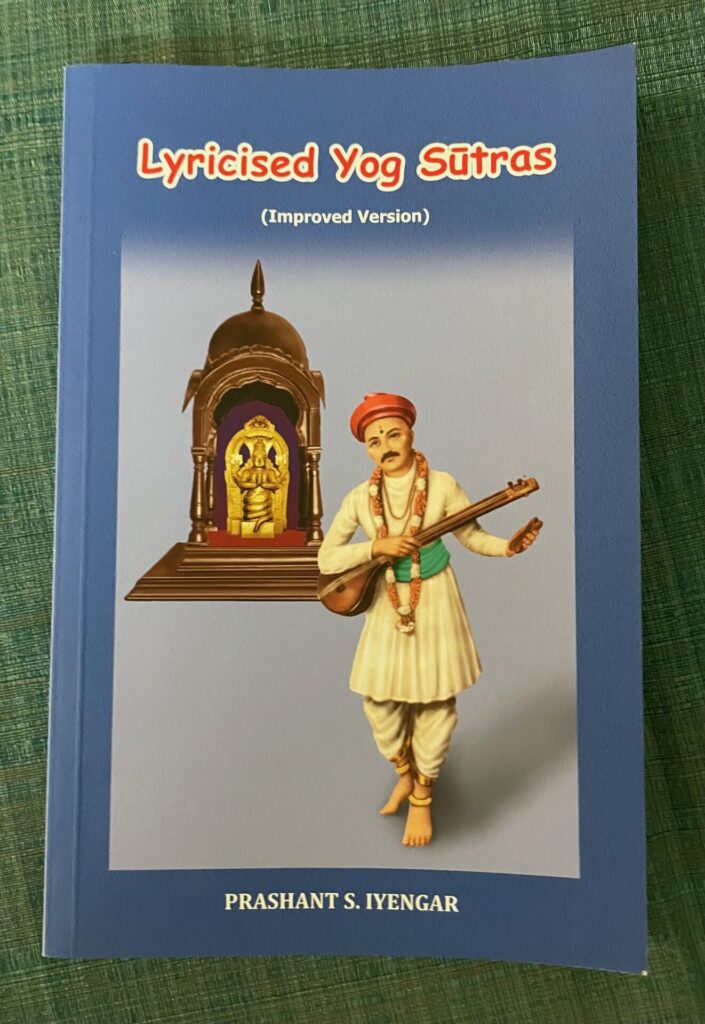Reading with Raya

I had to double up the posts today as this afternoon’s “visitor special” was a “reading circle” with Raya Uma-Datta, one of RIMYI’s more experienced teachers. And, he just gave such great hints on how to “read Iyengar” to bring depth and meaning to the “WHY we do what we do on the mat”. And, made the point that most of BKS Iyengar’s journey in yoga and reason for writing so prolifically was to answer the BIG QUESTION of “WHAT IS YOGA?”.
He reminded us of the amount of writings that Guruji left behind for our education in yoga. Outside of Light on Yoga (which also has an academic Introduction full of the philosophy of yoga), BKS Iyengar has 3 complete books dedicated to The Yoga Sutras of Patanjali, the foundational philosophy of Iyengar Yoga – Light on the Yoga Sutras of Patanjali, Core of the Yoga Sutras, and Patanjali Yoga Sutra Paricaya. Plus, many of his other texts such as Tree of Yoga (which we just read for Summer Bookclub), Light on Life (which we read many years ago), and the 8-volumes of Ashtadala Yogamala (that can be found in the IYNAUS store) are mainly dedicated to explaining the “WHAT” and “WHY” of yog-asana through the lens of philosophy, and not merely the physicality of it.
Below are some short tips Raya gave to our group. We know that all of us learn differently, are drawn to yoga for different reasons, and may find reading just daunting or uninteresting, so try something new!
- Through your physical practice, find one book that might be approachable, and start to have a “conversation” with yourself on those topics. Or, if you have heard BKS Iyengar or watched videos of his teachings, you might have a sense of his voice to even have a conversation with him about the text you are reading. “LISTEN to the writings” instead of just reading.
- “SEE THE SUTRAS”, don’t just read them. Raya had a great point that the Yoga Sutras could read like a really interesting screenplay. The first three sutras essentially give away “the plot”, but the fourth adds a “twist”. How we get out of the dilemma given by the plot twist is played out, but not without some struggles. And, after the struggles, the parting of clouds and beam of light coming through (key some great theme music) give us hope!!! Imagery can go a long way in creating a relationship with something we may find too “heady”.
- Create a timetable and evolution of the subject. Light on Yoga covers the topics of philosophy and asana much differently than Core of Yoga or Art of Yoga. To experience the evolution through the writing shows also the story of BKS Iyengar’s practice and reflection – Abhyasa and Vairagya – the Twin Pillars of Yoga.
- The “HEART of YOGA” is in the “WHY” we do asana. Doing is merely physical, reading is merely intellectual. In the “why” we discover the heart and soul of our practice. Bringing it all together is how we see the complete picture of Iyengar’s Yoga.
The other interesting thing Raya chose to read has been a major theme for me this year – the “vitamins of a yogi”. BKS Iyengar mentions them a couple of times in Tree of Yoga and they show up in Yoga Sutra I.20 : sraddha (faith), viriya (energy and courage), smrti (memory), samadhi (absorption), prajna (wisdom). They hit a bit differently for me this evening though. I find these “vitamins” quite accessible in my yoga “on the mat”, but have to admit I still struggle with them in certain areas of life! So, more conversation, more reflection, and maybe a story or two might help me find this grander connection…
I hope this helps some of you who might have so far been daunted by tackling some of the Iyengar texts! Find a way that speaks to you or shows you YOUR way to YOUR “why”.
(photo is NOT one of BKS Iyengar’s texts on the sutras, but the only one I have with me since it is small and easily readable while traveling)